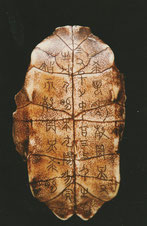Skype Learn Chinese--the bridge: A New Way to Mandarin Chinese
This book is written for English-speaking students who are taking Skype Learn Chinese courses. A basic level vocabulary and understanding of Chinese grammar and culture is presented in this Skype Learn Chinese series. It is an effort to introduce the Skype Learn Chinese students to the language by explaining its basic principles in simple steps. The purpose is to prepare the student with a foundation on which to build, with confidence, its ensuing complexities.
Skype Learn Chinese A New Way to Mandarin Chinese Lesson 10
Different Versions of Chinese Character Writing
A Summary
Skype Learn Chinese A New Way to Mandarin Chinese Lesson 10 Part I
The next step, Skype Learn Chinese still in the Shang dynasty, was to add a second root to the first root. This second root added an explanation for the use of Skype Learn Chinese, condition or activity of the first root, and it also was chosen to give the sound of the word. This is called a rebus, pictures of objects whose names suggest words or phrases. Note the rebus on the Skype Learn Chinese. A pictograph of a car and musical notes. The car is the first object. It indicates a general category in Skype Learn Chinese. The notes are the explanation that makes the meaning and sound of a word. So, the rebus is 'Car tune', for 'Cartoon'. That's the American pronunciation of (the second root) tune. The British pronunciation is ‘tyoon’, but the British would know the American way of pronouncing it and wouldn't take the trouble to find a British-sounding rebus for their own language. This is important in Skype Learn Chinese because this is what happened when the "Mandate of Heaven" passed to the Zhou in 1100BC. The scribes and scholars had little difficulty in understanding the Shang pictograms in Skype Learn Chinese , even though they spoke a different dialect (language) and didn't have a dictionary for Skype Learn Chinese.
In this way the language developed through the Warring States period, the Qin and the Han dynasties.Skype Learn Chinese made five major shifts in style to accommodate changes in media (knife, stylus and brush, on bone, bamboo, silk, and paper) and purpose (ancestors, official records, business, literature and painting). During the time that the Oracle Bones were being used (and before) this writing style probably was in use on bamboo strips, Skype Learn Chinese have perished. Let’s take a word through the changes: luó a ‘net to catch birds’, 1. 甲骨文jiǎ gū wén, shell-bone writing, is the name given to the Oracle Bone (knife-incised) script. 2. 金文 jīn wén, metal (gold) writing is the (embossed) writing on bronze vessels. Bronze has a golden color and it was the most highly prized metal during the Shang and Zhou dynasties, when Skype Learn Chinese were in vogue. 3. 小篆xiǎo zhuàn, Small Seal. This beautiful (stylus) script is still in use for Skype Learn Chiense. It developed in the Qin State during the Spring and Autumn (770-476 BC) from the large seal characters and became the first Skype Learn Chiese, official Chinese script when the Qin (221-206BC) unified control of the Chinese mainland. The Han (206BC—220AD) quickly took over the government of China, however, and, with Confucian scholars as officials, adopted a more efficient and practical writing system for inter-office communications, 4.隶书lì shū, Official (brush) script. This script developed into 5. 楷书 kǎi shū which remained, basically, the same (brush) script China used until the nineteen-fifties, almost two thousand years later.
Our Skype Learn Chinese class with professional tutors will help to know the history of Chinese characters.
Skype Learn Chinese A New Way to Mandarin Chinese Lesson 10 Part II

In 1949, however, Mao and the People’s Revolution consolidated China’s various district cultures into a national community and then, the introduction of general education produced a common language which used in Skype Learn Chinese, Mandarin, as the official spoken language and a simplified version of the written characters as the written language for all of the Chinese mainland also in our Skype Learn Chinese. This is added here as the sixth official change. The student can see how the simplification returns the written language to its original pictographs rather than the compositions, which, in two thousand years had blossomed into tens of thousands of complex forms.
In your Skype Learn Chinese class, we will help you to acquire standard Chinese--mandarin

